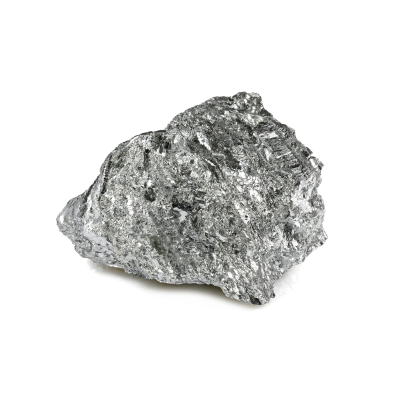Sb • Atomic Number 51

Antimony
Antimony is a silver-white, shiny, brittle metalloid, similar to arsenic. Its name likely derives from the Latin antimonium, which in turn comes from the Arabic name for the mineral antimony sulfide: itmid.
Although antimony can be found in its elemental form in nature, it is much more commonly found as the mineral stibnite, also known as gray antimony glance or antimonite. The element symbol Sb for antimony originates from stibnite and is derived from the Latin stibium.
Antimony is used in brake alloys and is ubiquitous as a flame retardant additive. It plays a critical role in the defense industry. As an alloying element, it imparts greater hardness and penetration power to lead bullets.
China is by far the world’s leading producer of antimony. In 2023, 60,000 tonnes of antimony were mined at the Xikuangshan Mine (“Twinkling Star”) in Hunan Province.
Antimony has been known since ancient times both as a metal and in its sulfide form. Fragments of a Chaldean vase made of antimony date back to around 4000 BC. Stibnite was used in ancient Egypt as eye makeup. Romans and Arab scholars applied antimony as a medicinal ingredient, mixing it into ointments and healing plasters. In the late Middle Ages, antimony was used as a laxative (e.g., in the form of tartar emetic).
In the 17th century, antimony was believed to have universal healing powers and was prescribed for various ailments. Its toxic nature only became known later.
The red tips of matches, invented in the first half of the 19th century, still contain antimony today.
Due to its toxicity, antimony today is used as a medicinal substance only in rare tropical diseases such as bilharzia and leishmaniasis.
About half of the world’s antimony production is used as a flame retardant additive. This makes the element ubiquitous—it is found in plastic housings of electronic devices, upholstered furniture, mattresses, and cable sheathing. The second-largest global application is in lead-acid batteries.
Various antimony compounds are also present in LCD and plasma displays. High-purity antimony is used in semiconductor technology to produce indium, aluminum, and gallium antimonide compounds for diodes and infrared detectors.
Antimony is also used in glass and ceramics manufacturing. In solar panels, antimony enhances heat resistance and improves the efficiency of perovskite solar cells by better capturing sunlight.
Within the USA, the defense industry accounts for 40 percent of antimony consumption. As an alloying element in lead, antimony provides hardness and corrosion resistance. According to the US Army, the raw material is a key element indispensable for a wide range of military applications, including explosives, ammunition, nuclear weapons, submarines, warships, night vision devices, laser sights, and communication equipment.
Because it is a dual-use material, China imposed strict export controls on antimony in December 2024, effectively halting exports and driving prices to historically high levels.
Antimony occurs in over 100 different mineral species, typically in association with mercury, silver, and gold. However, the most important antimony-bearing mineral is stibnite.
In 2024, global antimony mine production reached 100,000 tonnes, with 60 percent originating from China. China also holds the largest reserves, estimated at 670,000 tonnes, and dominates downstream processing, accounting for an estimated 85 percent of the global refining market. To maintain supply, China imports antimony concentrate, primarily from Russia and Tajikistan—the world’s second- and third-largest antimony producers, respectively.
Russia has the second-largest reserves worldwide, at approximately 350,000 tonnes. One of the key mining sites is the Olimpiada Mine in Siberia, operated by Polyus, a major gold mining company. In 2023, a quarter of global antimony production came from the Olimpiada Mine alone.
Although the United States has known antimony deposits, there is currently no active mining. However, US Antimonyoperates a smelting facility in the state of Montana, which runs at about half its annual capacity of roughly 4,000 tonnes.
Other notable producing countries include Turkey, Myanmar, Bolivia, and Australia.
Within the European Union, antimony deposits exist in France, Germany, Sweden, Finland, Slovakia, and Greece, but there is currently no active mining. The Canadian company Military Metals has acquired three antimony projects in Slovakia, including the Trojarova gold-antimony mine near Bratislava, which was closed in the 1990s.
China’s export controls on antimony and sanctions on Russia have triggered a price surge. Since early 2023, the price of antimony has nearly quadrupled.
Small quantities of antimony are also recovered through recycling, primarily from old batteries.
Selected organic compounds and hydrated aluminum oxide are used as substitutes for antimony-based flame retardants. Chromium, tin, titanium, zinc, and zirconium compounds can replace antimony chemicals in enamels, paints, and pigments. Combinations of calcium, copper, selenium, sulfur, and tin are used as alternatives to antimony-containing alloys in lead-acid batteries.
In ammunition, potential substitutes for antimony include bismuth and titanium.
https://www.faszinationchemie.de/artikel/news/antimon-unscheinbar-und-doch-allgegenwaertig
https://www.britannica.com/science/antimony#ref280568
https://pubs.usgs.gov/periodicals/mcs2024/mcs2024-antimony.pdf
https://www.crmalliance.eu/antimony
https://investor-magazin.de/2730antimon-das-metall-nach-dem-sich-die-grossmaechte-sehnen/
https://www.technik-einkauf.de/rohstoffe/kritische-rohstoffe/rohstoff-antimon-im-einkauf-327.html
https://www.newswire.ca/news-releases/global-antimony-shortage-is-a-ticking-time-bomb-for-the-u-s-military-845589719.html
https://www.globsec.org/what-we-do/press-releases/globsec-china-export-ban
https://www.fastmarkets.com/insights/russian-invasion-of-ukraine-squeezing-antimony-concentrates-market/
https://www.mining.com/web/russias-top-gold-miner-wants-become-global-player-antimony-market/
https://carboncredits.com/antimony-the-unsung-hero-of-solar-energy-and-national-defense/
https://www.fastmarkets.com/insights/us-antimony-talks-smelter-expansion-andrea-hotter/
https://www.acnnewswire.com/press-release/english/93164/military-metals-enters-into-loi-to-acquire-two-antimony-and-one-tin-property-in-the-european-union
https://www.reuters.com/markets/commodities/china-bans-exports-gallium-germanium-antimony-us-2024-12-03/
https://www.rfcambrian.com/wp-content/uploads/2025/02/rfc-ambrian-antimony-report-february-2025-new.pdf
https://www.theglobeandmail.com/investing/markets/stocks/MILI-CN/pressreleases/28915796/military-metals-enters-into-loi-to-acquire-two-antimony-and-one-tin-property-in-the-european-union/
Critical and Strategic Metals

